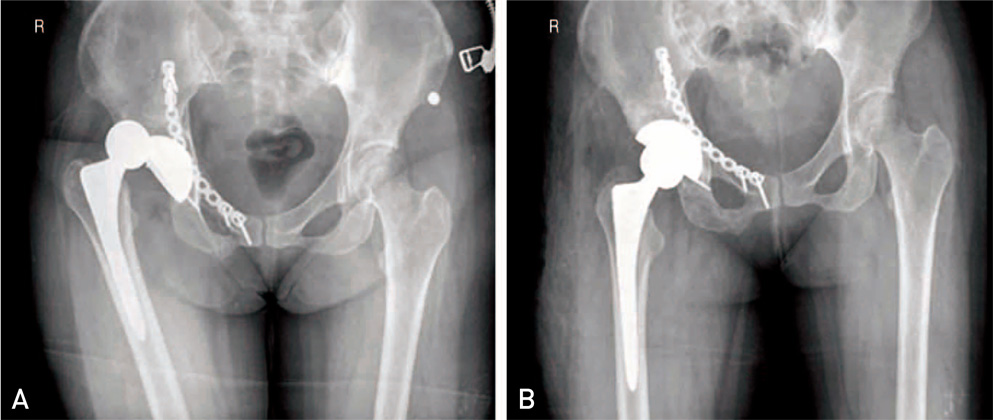Hip Pelvis.
2017 Dec;29(4):223-227. 10.5371/hp.2017.29.4.223.
Results of Total Hip Arthroplasty with 36-mm Metallic Femoral Heads on 1st Generation Highly Cross Linked Polyethylene as a Bearing Surface in Less than Forty Year-old Patients: Minimum Ten-year Results
- Affiliations
-
- 1Department of Orthopaedic Surgery, Daegu Catholic University College of Medicine, Daegu, Korea. cmr0426@cu.ac.kr
- KMID: 2424247
- DOI: http://doi.org/10.5371/hp.2017.29.4.223
Abstract
- PURPOSE
We evaluated long-term clinical and radiographic results in patients underwent primary total hip arthroplasty (THA) using 36-mm metallic femoral head and 1st generation highly cross-linked polyethylene among patients aged 40 years and less, with minimum 10 years follow-up.
MATERIALS AND METHODS
We retrospectively reviewed 20 hips underwent primary THA by one hip surgeon using 36-mm femoral head and 1st generation highly cross-linked polyethylene from 2004 to 2006. Mean follow up was 131.55 months. Clinical follow-ups included functional measurements. And we evaluated post operative complications, prosthesis loosening, failure, and osteolysis. For radiologic evaluations, together with position of acetabular cup at 6 weeks later of postoperation, we separately calculated the penentrations of femoral heads into polyethylene liners during postoperation and one year later check-ups, and during one year later check-ups and final check-ups. Polywear pro3D 5.10 software was used to measure penetrations of femoral head.
RESULTS
Mean acetabular cup inclination and anteversion were 49.02° and 10.19°, respectively. Mean thickness of the polyethylene liner at 45° was 6.44 mm. There were no major complications such as implant loosening or osteolysis, and one case of dislocation occurred. Average modified Harris hip score at final follow-up was 91, and Merle d'Aubigne and Postel scores 15 were or over. Average femoral head penetration of bedding wear was 0.170±0.039 mm/year. Steady-state wear rates was 0.059±0.006 mm/year.
CONCLUSION
Results of THA with 36-mm metallic femoral heads on 1st generation highly cross linked as a bearing surface in less than 40 year-old patients were satisfactory.
MeSH Terms
Figure
Reference
-
1. Schmalzried TP, Jasty M, Harris WH. Periprosthetic bone loss in total hip arthroplasty. Polyethylene wear debris and the concept of the effective joint space. J Bone Joint Surg Am. 1992; 74:849–863.
Article2. Bistolfi A, Crova M, Rosso F, Titolo P, Ventura S, Massazza G. Dislocation rate after hip arthroplasty within the first postoperative year: 36 mm versus 28 mm femoral heads. Hip Int. 2011; 21:559–564.
Article3. Geller JA, Malchau H, Bragdon C, Greene M, Harris WH, Freiberg AA. Large diameter femoral heads on highly cross-linked polyethylene: minimum 3-year results. Clin Orthop Relat Res. 2006; 447:53–59.4. Choi WK, Cho MR, Lee JH. Results of primary total hip arthroplasty with 36-mm femoral heads on highly cross-linked polyethylene-minimum seven-years follow-up. Hip Pelvis. 2014; 26:220–226.
Article5. Choi WK, Cho MR, Kim HS, Nam JH, Chae SB. Results of primary total hip arthroplasty using 36 mm femoral heads on 1st generation highly cross linked polyethylene in patients 50 years and less with minimum five year follow-up. Hip Pelvis. 2016; 28:76–81.
Article6. Cho MR, Lee HS, Lee SW, Choi CH, Kim SK, Ko SB. Results after total hip arthroplasty with a large head and bipolar arthroplasty in patients with displaced femoral neck fractures. J Arthroplasty. 2011; 26:893–896.
Article7. Engh CA, Bobyn JD, Glassman AH. Porous-coated hip replacement. The factors governing bone ingrowth, stress shielding, and clinical results. J Bone Joint Surg Br. 1987; 69:45–55.
Article8. Barrack RL, Mulroy RD Jr, Harris WH. Improved cementing techniques and femoral component loosening in young patients with hip arthroplasty. A 12-year radiographic review. J Bone Joint Surg Br. 1992; 74:385–389.
Article9. Willmann G. Ceramic femoral head retrieval data. Clin Orthop Relat Res. 2000; (379):22–28.
Article10. Jarrett CA, Ranawat AS, Bruzzone M, Blum YC, Rodriguez JA, Ranawat CS. The squeaking hip: a phenomenon of ceramic-on-ceramic total hip arthroplasty. J Bone Joint Surg Am. 2009; 91:1344–1349.
Article11. Lee JH, Lee BW, Lee BJ, Kim SY. Midterm results of primary total hip arthroplasty using highly cross-linked polyethylene: minimum 7-year follow-up study. J Arthroplasty. 2011; 26:1014–1019.
Article12. Dumbleton JH, Manley MT, Edidin AA. A literature review of the association between wear rate and osteolysis in total hip arthroplasty. J Arthroplasty. 2002; 17:649–661.
Article13. Babovic N, Trousdale RT. Total hip arthroplasty using highly cross-linked polyethylene in patients younger than 50 years with minimum 10-year follow-up. J Arthroplasty. 2013; 28:815–817.
Article14. Reynolds SE, Malkani AL, Ramakrishnan R, Yakkanti MR. Wear analysis of first-generation highly cross-linked polyethylene in primary total hip arthroplasty: an average 9-year follow-up. J Arthroplasty. 2012; 27:1064–1068.
Article15. Mont MA, Maar DC, Krackow KA, Jacobs MA, Jones LC, Hungerford DS. Total hip replacement without cement for non-inflammatory osteoarthrosis in patients who are less than forty-five years old. J Bone Joint Surg Am. 1993; 75:740–751.
Article
- Full Text Links
- Actions
-
Cited
- CITED
-
- Close
- Share
- Similar articles
-
- Results of Primary Total Hip Arthroplasty Using 36 mm Femoral Heads on 1st Generation Highly Cross Linked Polyethylene in Patients 50 Years and Less with Minimum Five Year Follow-up
- Results of Primary Total Hip Arthroplasty with 36-mm Femoral Heads on Highly Cross-linked Polyethylene-Minimum Seven-years Follow-up
- A Liner Breakage in Total Hip Arthroplasty after Using 1st Generation Highly Cross Linked Polyethylene Mated against 36-mm Metal Head: A Case Report
- The Wear Rate and Survivorship in Total Hip Arthroplasty Using a Third-generation Ceramic Head on a Conventional Polyethylene Liner: A Minimum of 15-year Follow-up
- Cementless Total Hip Arthroplasty Using Ceramic Femoral Head on Cross-Linked Ultra-High-Molecular Weight Polyethylene Liner in Patients Older than 65 Years: Minimum Five-Year Follow-Up Results


